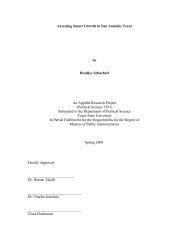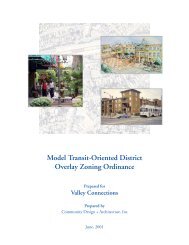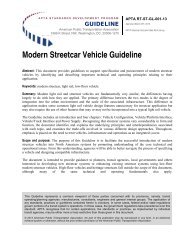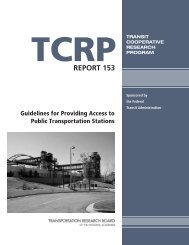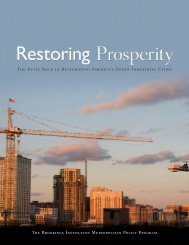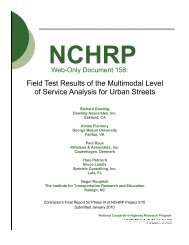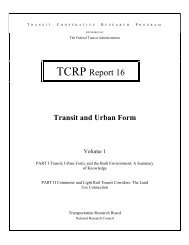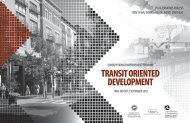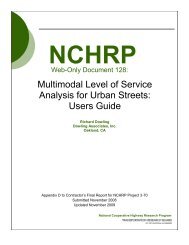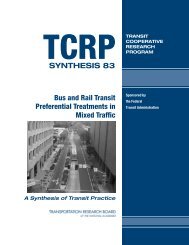Transit-Oriented Development in <strong>the</strong> StatesThe aging of <strong>America</strong> also points to a need for more transportation options. Today, 13 percent of <strong>America</strong>ns are over age65; by 2030, people over age 65 will make up nearly 20 percent of <strong>the</strong> nation’s population, a total of approximately 72million. 11 These older adults will require travel alternatives, since one in five people over age 65 do not drive. 12 Researchhas shown that non-drivers over age 65 who live in more densely populated areas with more transit options are morelikely to use transit and less likely to stay home on a given day because <strong>the</strong>y can get to needed services such as doctorappointments and grocery stores. 13Consumers increasingly want to live and work in walkable communities that offer transportation choices. A recent NationalAssociation of Realtors survey found that 77 percent of respondents wanted to live in pedestrian-friendly neighborhoods,and 50 percent favored transit improvements over o<strong>the</strong>r options. 14 In addition, 60 percent of respondentswere willing to live in a smaller house if it meant <strong>the</strong>ir commute would take less than 20 minutes. 15 An assessment ofwalkability’s effect on housing prices found a positive correlation between a walkable environment and increased homevalues in 13 of 15 markets included in<strong>the</strong> survey. 16 It is no surprise that livingnear transit seems to encourage moretransit ridership, as noted by a Caltransfunded<strong>report</strong> of TODs in California thatfound, “Residents living near transit stationsare around five times more likely tocommute by transit as <strong>the</strong> average residentworker in <strong>the</strong> same city.” 17Affordability also plays a significant rolein this trend. The 2012 Emerging Trendsin Real Estate <strong>report</strong> notes that, “Livingsmaller, closer to work, and preferablynear mass transit holds [increasing]appeal as more people look to manageexpenses wisely.” 18 Estimates indicatethat an individual can save more thanSource: <strong>Reconnecting</strong> <strong>America</strong>.$10,000 per year by riding public transitinstead of driving, and transit use rose with gas prices throughout 2011. 19 Potentially higher housing costs in areas nearemployment centers can be offset by lower transportation costs, with <strong>the</strong> additional benefit of avoiding long commutesin congested traffic. 20 According to <strong>the</strong> Center for Neighborhood Technology’s (CNT) Housing + Affordability Index,transportation costs account for only 9 percent of household costs in a transit-rich neighborhood, opposed to 25 percentfor households in an auto-dependent neighborhood. 21 The Index also found that, since 2000, transportation costs roseby more than $3,900 annually for families in more auto-dependent communities, compared to $1,400 annually in morewalkable, transit-supportive settings. 22The demand for transit access also is eliciting interest from developers, regional groups and city officials who hope toencourage economic development. Since a Portland, Ore., streetcar line was built in 2001, for example, 10,000 housingunits and 5.4 million square feet of office and retail space have been built within two blocks of <strong>the</strong> line, with total investmentsof $3.5 billion. 23 A Denver study also found that renters would pay an average of 4 percent more for units nearlight rail stops, and that developers have been paying about 25 percent more for land within a quarter-mile of rail stops. 24National Conference of State Legislatures | 2
Transit-Oriented Development in <strong>the</strong> StatesFederal Support for Transit-Oriented DevelopmentAt <strong>the</strong> federal level, several programs prioritize planning and funding for multi-modal transportation systems and developmentof services near transit stops. The U.S. Department of Transportation (DOT), <strong>the</strong> Department of Housingand Urban Development (HUD) and <strong>the</strong> Environmental Protection Agency (EPA) formed a Partnership for SustainableCommunities in 2009. The partnership has worked to coordinate investments and planning among <strong>the</strong> agencies to worktoward <strong>the</strong>ir shared goals, which include increasing transportation choices, supporting existing communities, promotingequitable and affordable housing, and enhancing economic competiveness. In addition, <strong>the</strong> partnership has helped tostreamline federal grants. One such example is a recent $96 million award in planning grants to help local communitiesalign <strong>the</strong>ir housing, transportation and workforce investments to maximize benefits.Ano<strong>the</strong>r major federal action that has positively affected <strong>the</strong> growth of transit-oriented development was a 2010 decisionby <strong>the</strong> Federal Transit Administration (FTA) to change its funding requirements to include not only cost-effectiveness,but also several additional criteria—mobility improvements, economic development and environmental benefits—toconsider when choosing projects. The new policy was due in part to lobbying by Twin Cities residents to add three lightrail stops in low-income areas to provide better access to light rail (pages 10-11). FTA also recently expanded fundingeligibility for bicycle and pedestrian facilities near transit. 25 Previously, only improvements within 1,500 feet of a transitstop could be funded; now, pedestrian amenities within a half-mile and bike facilities within 3 miles are eligible.The 27-month surface transportation reauthorization bill, Moving Ahead for Progress in <strong>the</strong> 21 st Century (MAP-21),signed into law in July 2012, includes $10 million in funding for a TOD pilot project for grants to states and localities.The money is to be used for station planning that enhances economic development and ridership, facilitates multimodalconnectivity and accessibility, increases access to transit hubs for pedestrians and bicyclists, and enables mixed-use development.26A particularly strong source of funding, <strong>the</strong> Transportation Investments Generating Economic Recovery (TIGER)grants, funds complex multi-modal and multi-jurisdictional projects. More than $2 billion in TIGER grants have beenawarded to date. Although <strong>the</strong> president’s FY 2013 proposed budget would make <strong>the</strong>se grants permanent, funding for<strong>the</strong> program was not included in MAP-21.State Support for Transit-Oriented DevelopmentState legislatures not only are asserting <strong>the</strong>ir role in shaping policies that support TOD near existing and planned transitlines and stations, but also are developing new infrastructure to support transit. Statutes in at least 22 states supportTOD in some manner. These range from states that simply define TOD to those that provide funding and incentivesto encourage TOD to create more transit choices for its citizens, drive economic development, and mitigate congestionand environmental impacts.Defining TODA state’s most common first step is to statutorily define transit-oriented development. Florida statutes, for example, defineTOD as “a project or projects, in areas identified in a local government comprehensive plan, that is or will be servedby existing or planned transit service. These designated areas shall be compact, moderate to high density developments,of mixed-use character, interconnected with o<strong>the</strong>r land uses, bicycle and pedestrian friendly, and designed to supportfrequent transit service operating through, collectively, or separately, rail, fixed guideway, streetcar, or bus systems ondedicated facilities or available roadway connections.” 27While many developers and governments consider TOD in terms of fixed-rail service, that is not always <strong>the</strong> case. Atleast 12 states specifically include bus rapid transit (BRT) service as an eligible TOD mode (see below). Florida, MaineNational Conference of State Legislatures | 3



